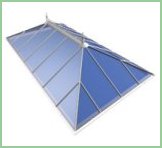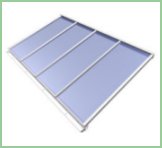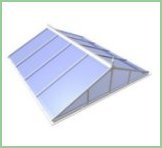Conservatory Roofs
Liv Supplies is able to provide a range of high quality, long lasting and affordable conservatory roofs. With a selection of designs available from full Victorian facet style to lean-to designs, all of our conservatory roofs are guaranteed to impress your guests with great style and an attractive appearance, while also being long lasting and able to withstand the harsh British weather for many, many years to come.
The polycarbonate conservatory roofs available from Liv Supplies are made to our own through standards and can be produced to either coloured or unglazed designs. As well as conservatory roofs, the same feature can also be used as canopies, carports, door canopies and a range of further uses.
Buy Conservatory Roofs from Liv Supplies
Making the correct choice from the wide selection of conservatory roofs currently available for your conservatory is an important decision and one that needs to be carefully considered. Liv Supplies is able to provide you with as much assistance, recommendations and advice as is needed when choosing one of the appropriate conservatory roofs for your structure so please don't hesitate to get in contact should you require any help.
The appearance of conservatory roofs is one of the most important decisions many people have to make when they are having a new conservatory installed, especially if you are planning on using it all year round. A low cost roof may initially be more affordable but the increased heating bills during the colder months could very well increase the long-term running costs to yourself. Further to this, a south facing conservatory may become too hot and uncomfortable to stay in during the summer months if the entire range of conservatory roofs and designs is not carefully considered.
Why Polycarbonate Conservatory Roofs?
The easiest and simplest reason is the durability which polycarbonate provides. Polycarbonate conservatory roofs are highly durable and can stand the harshest environments and temperatures. Due to the durability they provide, it’s guaranteed to last longer.
Cleaning Polycarbonate Conservatory Roofs
Polycarbonate conservatory roofs require extra care when cleaning in order to maintain their long lasting qualities and extend the life of our conservatory roofs for as long as possible. Common household cleaning products may damage the protective coating applied to our conservatory roofs to help shield you from harmful UV rays, we would advise never scrubbing our polycarbonate conservatory roofs with brushes as well as avoiding all abrasives and petrol based cleaners or those with an alkaline composition. You should also avoid cleaning our conservatory roofs on very hot days. Mild warm soapy water is safest to use when cleaning Liv Supplies' conservatory roofs, thoroughly rinsing it with clean water afterwards.
 Edwardian / Georgian Conservatory Roofs
Edwardian / Georgian Conservatory Roofs
Edwardian style conservatories and conservatory roofs are predominantly square or rectangular which makes them slightly easier to construct than Victorian ones.
A combination of elegance with maximum space, Edwardian conservatories and there classic conservatory roofs are a very popular choice with our customers.
Our traditional Lean-to Conservatory Roofs offer refreshingly clean lines, give maximum living space for any given area and feature a high-insulating, multi-walled, polycarbonate roofing system up to 35mm thick.
 3 Facet Victorian Conservatory Roofs
3 Facet Victorian Conservatory Roofs
Liv Supplies' 3 Facet conservatory roofs are how they looks on the picture, with 3 triangular shapes at the front. Victorian conservatories take their design from the great Victorian houses so that when completed they look as original as can be. Curves and arches are the style cues to spot. Enhancing your home naturally and stylishly while making it even more comfortable and rewarding to live in.
Our Gable ended conservatory roofs have a flat faced frontage, providing extra height and allowing increased light into your room.
This is a simple design but gives stunning results.
 5 Facet Victorian Conservatory Roofs
5 Facet Victorian Conservatory Roofs
5 Facet Victorian Conservatory Roofs are how they looks on the picture, apart from 5 triangular shapes at the front instead of the 3 shown. Victorian conservatories take their design from the great Victorian houses so that when completed they look as original as can be. Curves and arches are the style cues to spot.
Enhancing your home naturally and making it even more comfortable. Classic and elegant a Victorian conservatory works equally well with modern houses, too. It's timeless.
Click here to view our Conservatory Roofs
Not what you're looking for? We also stock and supply;
- Polycarbonate
- Polycarbonate Roofing Panels
- Polycarbonate Sheets
- Cut to size Perspex
- Cut to size Acrylic
- Polycarbonate Conservatory Roofs
- Polycarbonate Greenhouse
- Polycarbonate Panels
- Sheet Plastic
- Carports and Canopies
- Acrylic Plastic
- Polypropylene Plastic / Correx
Conservatory Roof (Greenhouse roof)
A Conservatory, as it are known today, had origins in the 16th century when wealthy landowners sought to cultivate citrus fruits such as lemons and oranges that began to appear on their dinner tables brought by traders from warmer regions of the Mediterranean.
Conservatory history
Preservation of citrus and other tender plants started out as crudely as building a pergola over potted plants or beds or simply moving potted plants indoors for the cold season. Known in Italy as limonaia, these early structures employed wood panels in storerooms or open galleries to protect from the cold.
Further north in Europe, the preservation of orange trees became the trend with special purpose buildings built to protect the tasty, but delicate fruit. Orangeries, as they came to be called were typically enclosed structures built with wood, brick or stone with tall vertical windows on the south walls. Use of these rooms expanded socially and practically, being used to entertain and to host a wider variety of plants. The term greenhouse came to describe the rooms and conservatories for tender plants. In the 18th century a Dutch scientist pioneered the use of sloping glass to bring in more light for the plants than the tall glass side walls of orangeries.
The 19th century was the golden age of conservatory building, primarily in England. English conservatories were the product of English love of gardening and new technology in glass and heating technology. Many of the magnificent public conservatories, built of iron and glass, are the result of this era. Kew Gardens in London is an example of a large greenhouse used for growing tender and rare plants, or, less often, for birds and rare animals – sometimes with the plants and animals living together.
Many cities, especially those in cold climates and with large European populations, have built municipal conservatories to display tropical plants and hold flower displays. This type of conservatory was popular in the early nineteenth century, and by the end of the century people were also giving them a social use (e.g., tea parties). Conservatory architecture varies from typical Victorian glasshouses to modern styles, such as geodesic domes. Many were large and impressive structures and are included in the list below.
The widespread construction of UK conservatories came to a halt with the onset of World War II. While the advent of insulated glass in the 1950's and 1960's saw the development of simple sunroom structures, it was not until the 1970's that creative architects and builders began to recreate the Victorian styling of 19th century English conservatories in smaller domestic versions using insulated glass.
In the UK there is a legal definition of a conservatory, it is a building that has at least 50% of its side wall area glazed and at least 75% of its roof glazed with translucent materials, either polycarbonate sheeting or glass. Today, the term sunroom, solarium and conservatory are used interchangeably by the public, but in general the term conservatory and particularly English conservatory evoke the image of an ornate structure, echoing the traditions of that Victorian era of conservatory building.




 Lean To Conservatory Roofs
Lean To Conservatory Roofs Gable Conservatory Roofs
Gable Conservatory Roofs